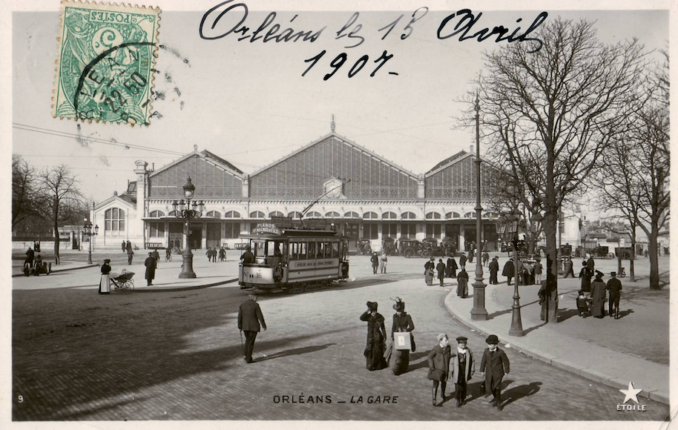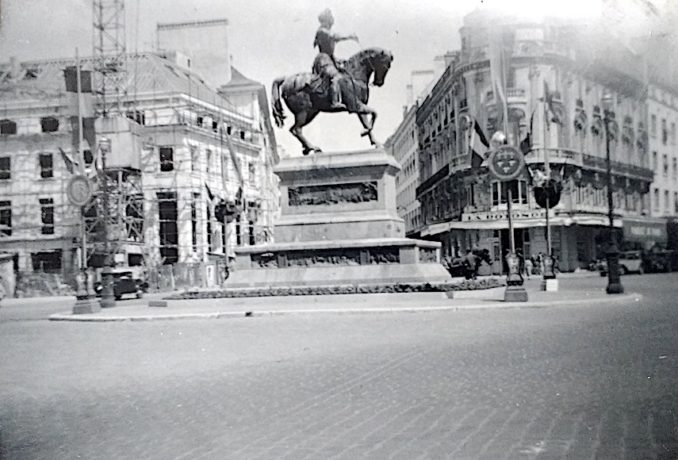
© Always Worth Saying 2022, Going Postal
In the old photo above we observe Orléans cathedral at the end of a wide cobbled street with a row of cars parked on the right hand side. Not its real name (Basilique Cathédrale Sainte-Croix d’Orléans), the cathedral was built in the gothic style during the half-century between 1278 and 1329. This was the place of worship for Jean D’Arc during her successful defence of the city against the English during the siege of 1428-1429, but it was destroyed in 1568 by the Huguenots during the French Wars of Religion.
In the modern day, the avenue has a tram line down the left-hand side. This belongs to line B (pronounced ‘buh’) of the Orléans Metro system. The rails are nicely sunk into the cobbled street with a square-trimmed hedge central reservation separating the iron way from a tarmac road to the right. Free of gaudy street and shop signs the area presents a pleasant and uncluttered facade and is described in the guide books as a ‘pastry and patrimony’ central shopping street of ‘chic shops and eccentric emporia’ with iconic views of the cathedral.
To the right-hand side of the photographer, and out of view, sits a Place de Republic which includes a particularly bad statue of Marianne for some reason pressing her posey to her belly button rather than holding it triumphantly aloft. To the left, the two arches are those of the modern-day Orléans campus of the ISC Paris Grande École, a prestigious business school ranked the 110th best university in the world. Originally founded in Paris in 1963, the Ecole took over Orlean’s older Anatole Bailly University in 2019. The master’s degree programmes cost a reasonable E11,500 Euros which compares very favourably to the standard £9,250 a year for our own university of Craptown degrees in the likes of Surf Science and Golf Management Studies.
At the far end of the street (named the Avenue de Jeanne D’Arc), we can see the twin-towered western frontage of the cathedral with a spire to the rear – like Notre Dame in Paris. What we can’t see, as the perspective doesn’t allow, is a pleasant square before the cathedral which continues the un-cluttered look.
As for line B, it runs from north to south, intersects with line A on the banks of the Loire, was competed as recently as 2005, carries 77,000 passengers a day, has 25 stops and is operated by 21 modern Alstom Citadis trams.
Route B also passes the mainline Gare D’Orléans, a surprisingly horrible building, so awful I suspect the locals called it ‘Anglo-Saxon’. Much better in the old days:

Vue en gros plan d’une rame de l’ancien tramway d’Orléans,
Scanned by Claude_villetaneuse – Public domain

© Always Worth Saying 2022, Going Postal
A statue of Joan of Arc sits in an airy public square, La Place du Martroi, off the Rue Jeane D’Arc to the west and north of the cathedral, a hand grenade’s throw from the Mosque de Ibn-Badis.
The work is by Denis Foyatier and is produced in the neoclassical style. Foyatier’s other works include this, this, this and this.
Well. Puffins will be pleased to note that M. Foyatier took time out from liberating the male genitals and bare bottoms concealed in base metal and bare stone, to sculpt a woman on horseback. Albeit one who dressed up as a man. All very French.
His poor wife was Antoinette Jenny LaForge who gave him four daughters. Two of whom married recipients of the Légion d’honneur. Daughter Marie’s husband was Jules Blanchard, also a sculptor. Pauline’s spouse was General Denis François Félix De Loye.
It was in 1429 that the peasant maid of Orléans saved the city from the English during the Hundred Years War. This was the first success the French had had since their defeat at Agincourt in 1415, 14 years earlier, and allowed for the coronation of King Charles VII at Rheims. Or was it? More of a strategic withdrawal by the English than a defeat, Joan of Arc was captured the following year. In her trial, it emerged that she was a heretic possessed by the devil who dressed in men’s clothes and had been acting on visions sent by Satan.
After being convicted and repenting, Joan continued to have visions and to wear men’s clothing meaning, as a lapsed heretic, one was obliged to sentence her to death, burn her at the stake and throw her in the Loire.
In the modern day, the square is pedestrianised but has twin tram tracks running around the periphery. The cobbled surface has been replaced by attractive stone slabs finished in a variety of textures. Again, if anything, unlike every urban area in Britain, the effect is more pleasing than seven decades ago. Not as sure about the trees in green buckets. They do little more than spoil the view. Being in buckets they are easily moved and are replaced by the Orléans Eye and a Christmas market during Advent.
In the old photo, the building to the left is being rebuilt. Scaffolding has been erected and new windows and a new roof with skylights is being installed.
Behind the statue a horse can be seen, presumably pulling a cart obscured by the plinth below Joan’s own mount.
To the right and above the cart horse, a sign is partly obscured but will say ‘La Rotonde’, as ‘La Rotonde’ still appears in stone above the building’s entrance. The corner is now a shoe shop. A flat iron style structure designed by architect Hubert, the foundation stone was laid on Sunday, July 18, 1897, with the completed building inaugurated on April 30th 1898.
There is another Rotonde to the right, off camera, with the pair of them guarding this end of the Rue de Republique. The avenue behind the statue is Rue Bannier. Small independent shops sit on the bottom story of the thorofare’s uniformly five-story high somewhat slab-sided buildings. Rue de Republique has fared better with the effect being more Belle Epoc and less early post-war pre-fab.

Immeuble La Rotonde, place du Martroi, Orléans-, France,
Gilbertu Bochenek – Licence CC BY-SA 4.0
The building being restored has become the CIC bank. CIC being Crédit Industriel et Commercial, one of the top five banking groups in France. To the left of that and out of sight is the BNP building. Not that BNP, but the offices of the Bank National de Paris. Very much the financial district, behind the photographer sits the Chambre De Commerce. You can have a good look around the square on Street View here.
During the Second World War, Orléans was occupied by the Germans and became an important transport hub. A large freight yard is located at Fluery-Les-Aubrais about one and a half miles from Gare d’Orléans. Being only 74 miles from Paris and a crossing point of the River Loire, the city was heavily bombed by the Americans in anticipation of D-Day. Between the 19th and 23rd of May 1944 over three hundred civilians were killed in raids. Also in May, 170 USAF Liberators saturation bombed a nearby airfield.
After hostilities ended, Orléans was one of the first French cities to be rebuilt, much of it in pre-fabricated concrete sections – hence the uniformity of design in the streets radiating from Place du Martroi.
When my father and grandparents visited, only seven years after the war, work was still continuing on what was to become the CIC building pictured above. In 1952 the urban area had a population of about 76,000 which has risen to 117,000 in the present day.
Also in 1952, the Dundee Currier reported the Rev John MacLean, chairman of the Dundee Orléans Fellowship, had struck out for France accompanied by the 24th Dundee Company of the Boys’ Brigade. The Rev MacLean planned to be in Orléans for a Joan of Arc celebration to be held on May 8th. Once there, the Boys’ Brigade pipe band would take part in the event, not least by playing ‘Scots Wha Hae’. The Reverand informed the Currier that ‘Scots Wha Hae’ had been played when the French heroine entered Orléans 500 years previously and ‘probably hasn’t been heard there since.’ The Lion Rampant and the St Andrew’s Cross would also be processed.
Your author vaguely recalls from his school days mention of an ‘Auld Alliance’ between England’s regularly defeated northern and southern Third World neighbours.
Following up the story on the 13th of May, the Currier reported the visit to have included the administering of the following dreadful poem to the Mayor of Orléans. A Captian M’Kechnie of the Boys’ Brigade recited the following dire non-stanzas by Armstrong Barry;
The pipers play at Orléans
The pipers from the Tay,
Within it swings the tartan
On France’s festal day.
There the village maiden saw
The dawning of her dreams,
From thence the pathway open’d
To that great day at Rheims.
If, in the heav’nly places,
Where perfect radios are,
They tune in to the music
Of this our earthly star,
St Joan will be asking,
And sure she’ll have her way,
Leave from celestial duties
To hear the pipers play.
Oh dear me. Worse than that, the movie reels were on hand to record it all. This from Pathe:
One might prefer to be set on fire and thrown in the Loire.
© Always Worth Saying 2022



